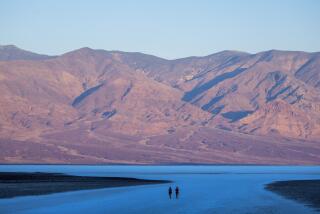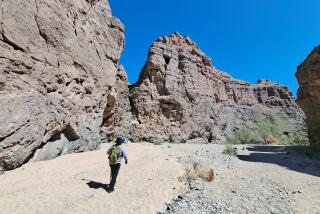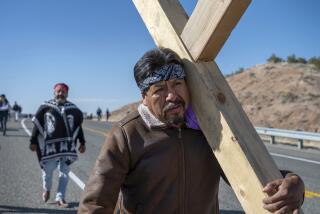Legend of the Banished Shaman Captures Imaginations
For more than 3,000 years, the wrathful spirit of a banished Cahuilla shaman named Tahquitz has kept watch over his namesake canyon in the rugged, boulder-strewn San Jacinto Mountains.
For just as long, the Agua Caliente Band of Cahuilla Indians has produced lesson-legends as wondrous and complex as the desert landscape itself.
Tahquitz Canyon has been Shangri-La to filmmakers, hippies, hermits, the homeless and the legendary Tahquitz.
Only a few minutes southwest of downtown Palm Springs, the new Tahquitz Canyon Visitor Center--operated by the Cahuilla Indians, who created the Tahquitz myth millenniums ago--is a place where tourists can view old photographs, ancient Indian artifacts and a 15-minute film on the âLegend of Tahquitz.â
To this day, legend has it, Tahquitz (pronounced Taw-kwish) continues to consume the souls of those foolhardy enough to venture into his canyon. Some tribe members refuse to enter, just to be safe.
So powerful is Tahquitz, believers say, that he can manifest himself in various forms: an earthquake, an animal, lightning, an old man or a meteor.
Through the centuries, Tahquitz has been blamed for desert mayhem, including deaths, drought, famine, flash floods, fires and just plain bad luck. Even today, when the earth shakes, local Indians say Tahquitz is up to his old tricks.
Of course, the legendary curse doesnât worry everyone.
Tribal Ranger âMountain Bobâ Hepburn, for example, takes groups into the canyon every day, twice a day, for guided two-mile hikes. The curse seems to roll off his back like water over the falls.
To him, the canyonâs beauty is far more meaningful than a myth.
âThis canyon and these rocks seem to bring something out in the spirit of the people who come here,â he said.
Along the hike, Hepburn points out wildlife, ancient rock art and a century-old irrigation system, all while detailing the many uses of dozens of native plants.
The creosote bush, for example, was the Cahuillasâ medicine chest, used for everything from lung congestion to bowel complaints. The red barrel cactus, which is dark green with red spines, was used like a Crock-Pot, to cook meals. Jojoba was used as shampoo.
Wending his way past âAunt Rockâ--named for a much-loved Indian goddess who is said to have disappeared and then reappeared in the form of a rock--Hepburn treks up-canyon with the sure-footedness of the native bighorn sheep.
Eventually, he reaches a sycamore-shaded paradise where there usually is a 60-foot waterfall. These days itâs dry because of a four-year drought. This tranquil oasis doubled as a mythical paradise in Frank Capraâs 1937 classic movie âLost Horizon,â starring Ronald Colman and Jane Wyatt. In Capraâs adaptation of James Hiltonâs romantic fantasy of Shangri-La, the Himalayan paradise where no one grows old, a film crew had to lift Wyattâs white horse to the top of the falls with a winch.
The canyonâs blend of mythical malevolence and natural beauty--even with the mercury stuck at 110--has been embraced by writers, explorers and those who merely take delight in the outdoors.
A nature writer, Joseph Smeaton Chase, encountered the canyonâs dark side in the early 1920s, when he heard things go bump in the night. Sleeping with his ear to the ground, he was awakened by âTahquitzâ making sounds like boulders crashing down from the mountains.
Although he returned safely to write about his ordeal in âOur Araby,â a 1922 Palm Springs guidebook, others havenât been so lucky.
Since the Palm Springs mounted police search and rescue unit was formed more than half a century ago, its members have pulled more than 30 corpses from the canyon, some of them left after homicides, others the remains of luckless hikers.
Professional free spirit and songwriter Eden Ahbez found unexpected fame after he sat down on a hot, sunny boulder and wrote his autobiographical song âNature Boy,â which was popularized by Nat King Cole in 1948. His bohemian ways later inspired flower children, war veterans and the homeless to take up residence in the canyonâs caves.
In 1969, during spring break, thousands of teenagers flooded into Palm Springs for a rock concert. Afterward, a rowdy crowd wound up in the canyon, where they spent days skinny-dipping in the canyonâs icy pools and dancing on its boulders.
Finally, police evicted them and slapped a âclosedâ sign on the canyon. It stayed there for 30 years--until the Cahuillas built their visitor center, cleaned up the canyon and reopened it last year for guided hikes only.
The canyonâs mouth is right in Palm Springs, where Cahuilla Indians built the Coachella Valleyâs first village more than 3,000 years ago. They called it Sekhi, which means âsound of boiling water,â for its natural hot springs. Today, the site is occupied by the Spa Resort Casino, where health and wealth can be sought in tandem.
Other springs were discovered too, eventually giving the city its name. Even after thousands of years, Sekhi remains the areaâs hottest spring, at 104 to 106 degrees, according to Tribal Ranger Rocky Toyama.
Like its subject, the Tahquitz legend takes many forms. Some versions credit Tahquitz with strewing boulders all over the mountainside. The demon and an angry chief are said to have tossed them at each other in a great duel.
The way the Agua Caliente band of Cahuillas tells it, shaman Tahquitz first practiced his healing art with good effect, controlling the food supply and weather and curing disease by sucking out the evil with his mouth and blowing it away.
But gradually and mysteriously, evil seeped into his heart. He began to wreak havoc on his people by causing illness and discomfort and making the animals leave the canyon. Soon his name inspired fear. For using his supernatural powers for harm rather than good, he was banished from the tribe.
Scaling the granite cliffs, he made his home in a cave at the far end of the canyon, beneath a 1,000-foot boulder that eventually would be called Tahquitz Rock by the Indians and Lily Rock by white settlers in the town of Idyllwild. (Today, it is popular with rock climbers, who prefer Tahquitzâs fierce appellation.)
Bitter and angry over his exile, Tahquitz became downright dangerous. Emerging from his cave in various forms, he kidnapped and killed young Indians, feeding on their souls. When he spotted the beautiful maiden Cawisicela, whose name means âThe Foxâs Dress,â swimming in an emerald pool, he was consumed with lust.
Despite her cries for help, he carried her off to his mountain hideaway. There he kept her for several months, forcing her to help him consume souls until he could no longer endure her misery. But before he set her free, he made her promise not to tell her people what had happened until three years had passed. Returning to her village, she was welcomed with open arms. As promised, she remained mute about her ordeal--for a while. But after months of tribal eldersâ badgering about what had happened, she broke down and divulged her secret.
That was a big mistake. Although she appealed for pity and mercy, her tribesmen were appalled that she had become Tahquitzâs âwife,â even unwillingly, and had eaten the souls of their brothers. Heartbroken and alone, she went to bed that night and died in her sleep.
Although there are many lessons to be learned from this legend, Toyama distills it this way for schoolchildren: âDonât abuse your power; use it wisely for the good of all others. When you make a promise, keep it. And donât ever try to weasel a secret out of someone, or something might happen to you.â
More to Read
Sign up for The Wild
Weâll help you find the best places to hike, bike and run, as well as the perfect silent spots for meditation and yoga.
You may occasionally receive promotional content from the Los Angeles Times.






